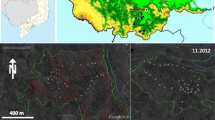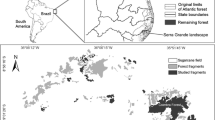Abstract
We studied the diversity, community composition and natural regeneration of woody species in an isolated but relatively large (> 1,000 ha) dry Afromontane forest in northern Ethiopia to assess its importance for regional forest biodiversity conservation. The principal human-induced disturbance regimes affecting this forest include logging and livestock grazing. Vegetation data were collected in 65 plots (50 m × 50 m); seedling species composition and density were determined in 10 m × 10 m nested plots. We used a cluster analysis to identify plant communities and non-metric multidimensional scaling (NMDS) ordination to investigate environmental factors that influenced the distribution of the emergent plant communities. Three plant communities were identified: a Juniperus procera-Maytenus senegalensis community, which represented a phase of the potential natural dry Afromontane forest vegetation on steep slopes with shallow soils, a Pterolobium stellatum-Celtis africana community, found on more mesic sites, and a Cadia purpurea-Opuntia ficus-indica community, typically representing severely disturbed habitats. Altitude, slope, soil depth and distance to the nearest stream, which we collectively interpreted as a moisture gradient, and forest disturbance separated the plant communities. With only 39 of the 79 recorded woody species present in the seedling layer, the forest currently faces an extinction debt of 50 per cent of the total woody species pool. Human disturbance has clearly affected plant species diversity in this forest as degraded plant communities typically lacked the commercially interesting or otherwise valuable tree species, were encroached by shrubs and in areas severely invaded by alien species. Further disturbance will most likely result in additional declines in biodiversity through local extinction of indigenous tree species. Despite the problems associated with conserving plant species diversity in small and isolated populations, this relic forest is of particular importance for regional conservation of forest biodiversity, as species with high conservation value, such as Afrocarpus falcatus, Allophylus abyssinicus and Bersama abyssinica, are still present as mature trees, and as other forest fragments in the region are two orders of magnitude smaller, and therefore more heavily impacted by small population sizes and unfavourable edge effects. Forest management should focus on avoiding further degradation, increasing natural regeneration and improving stakeholder participation.



Similar content being viewed by others
References
Aerts R, Negussie A, Maes W, November E, Hermy M, Muys B (2007) Restoration of dry Afromontane forest using pioneer shrubs as nurse plants for Olea europaea ssp. cuspidata. Restorat Ecol 15:12–138
Aerts R, November E, Maes W, Van der Borght I, Negussie A, Aynekulu E, Hermy M, Muys B (2008) In situ persistence of African wild olive and forest restoration in degraded semiarid savanna. J Arid Environm 72:1131–1136
Aerts R, Van -Overtveld K, Deckers J, Haile M, Hermy M, Muys B (2006) Species composition and diversity of small Afromontane forest fragments in northern Ethiopia. Pl Ecol 187:127–142
Aerts R, Van Overtveld K, November E, Wassie A, Abiyu A, Demissew S, Daye DD, Giday K, Haile M, TewoldeBerhan S, Teketay D, Teklehaimanot Z, Binggeli P, Deckers J, Friis I, Gratzer G, Hermy M, Heyn M, Honnay O, Paris M, Sterck FJ, Muys B, Bongers F, Healey JR (2016) Conservation of the Ethiopian church forests: threats, opportunities and implications for their management. Sci Total Environm 551--555:404–414
Aguirre-Gutiérrez J (2014) Are plant species’ richness and diversity influenced by fragmentation at a microscale? Int J Biodivers ISSN 2314–4149
Amare D, Mekuria W, T/wold T, Belay B, Teshome A, Yitaferu B, Tessema T, Tegegn B (2016) Perception of local community and the willingness to pay to restore church forests: the case of Dera district, northwestern Ethiopia. Forest, Trees & Livelihoods DOI: 10.1080/14728028.2015.1133330
Assefa A, Abate D, Stenlid J (2014) Characterization of Corynelia uberata Fr., a putative fungal pathogen of Podocarpus falcatus in Ethiopian forests. Forest Pathol 44: 45–55
Aynekulu E, Denich M, Tsegaye D (2009) Regeneration response of Juniperus procera and Olea europaea subsp. cuspidata to exclosure in a dry Afromontane forest in northern Ethiopia. Mountain Res Developm 29:143–152
Aynekulu E, Denich M, Tsegaye D, Aerts R, Neuwirth B, Boehmer HJ (2011) Dieback affects forest structure in a dry Afromontane forest in northern Ethiopia. J Arid Environm 75:499–503
Aynekulu E, Aerts R, Moonen P, Denich M, Gebrehiwot K, Vagen T-G, Mekuria W, Boehmer HJ (2012) Altitudinal variation and conservation priorities of vegetation along the Great Rift Valley escarpment, northern Ethiopia. Biodivers & Conservation 21:2691–2707
Benítez-Malvido J, Martínez-Ramos K (2003) Impact of forest fragmentation on understory plant species richness in Amazonia. Conservation Biol 37:389–400
Beven K, Kirkby MJ (1979) A physically based, variable contributing area model of basin hydrology. Hydrol Processes 24:43–69
Boehmer HJ (2011) Vulnerability of tropical montane rain forest ecosystems due to climate change. In: Brauch, Hans Günter; Oswald Spring, Ú.; C. Mesjasz, J. Grin, P. Kameri-Mbote, B. Chourou, P. Dunay, J. Birkmann (eds) Coping with global environmental change, disasters and security – threats, challenges, vulnerabilities and risks. Hexagon series on human and environmental security and peace, vol. 5, Berlin – Heidelberg – New York: Springer, pp 789–802
Boehmer HJ, Richter M (1997) Regeneration of plant communities – an attempt to establish a typology and zonal system. Pl Res Developm 45:74–88
Boehmer HJ, Wagner HH, Gerrish GC, Jacobi JD, Mueller-Dombois D (2013) Rebuilding after collapse: Evidence for long-term cohort dynamics in the Hawaiian rainforest. J Veg Sci 24:639–650
Botzat A, Fischer L, Farwig N (2015) Regeneration potential in South African forest fragments: extinction debt paid off or hampered by contemporary matrix modification? Pl Ecol 216:535–551
Conservation International (2007) Biodiversity hotspots, Arlington, USA
Cousins SAO (2009) Extinction debt in fragmented grasslands: paid or not? J Veg Sci 20:3–7
Darbyshire I, Lamb H, Umer M (2003) Forest clearance and regrowth in northern Ethiopia during the last 3000 years. The Holocene 13:537–546
Demissew S (1988) The floristic composition of the Menagesha State Forest and the need to conserve such forests in Ethiopia. Mountain Res Developm 8:243–247
Dufrene M, Legendre P (1997) Species assemblages and indicator species: the need for a flexible asymmetrical approach. Ecol Monogr 67:345–366
Ellstrand NC, Elam DR (1993) Population genetic consequences of small population size: implications for plant conservation. Annual Rev Ecol Syst 24:217–242
Engelbrecht BMJ, Comita LS, Condit R, Kursar TA, Tyree MT, Turner BL, Hubbell SP (2007) Drought sensitivity shapes species distribution patterns in tropical forests. Nature 447:80–83
Fahrig L (2003) Effects of habitat fragmentation on biodiversity. Annual Rev Ecol Evol Syst 34:487–515
Farwig N, Sajita N, Schaab G, Böhning-Gaese K (2008) Human impact diminishes seedling species richness in Kakamega Forest, Kenya. Basic Appl Ecol 9:383–391
Flombaum P, Sala OE (2008) Higher effect of plant species diversity on productivity in natural than artificial ecosystems. PNAS 105:6089–6090
Friis I, Demissew S, Van Breugel P (2010) Atlas of the potential vegetation of Ethiopia. Biologiske Skr 58:1–307
Grass I, Brandl R, Botzat A, Neuschulz EL, Farwig N(2015) Contrasting taxonomic and phylogenetic diversity responses to forest modifications: comparisons of taxa and successive plant life stages in South African scarp forest. PLOS ONE 10(2):e0118722
Haila Y (2002) A conceptual genealogy of fragmentation research: from island biogeography to landscape ecology. Ecol Applic 12:321–334
Harper JL (1977) Population biology of plants. Academic Press, London
Hemp A (2006) Continuum or zonation? Altitudinal gradients in the forest vegetation of Mt. Kilimanjaro. Pl Ecol 184:27–42
Hill MO (1973) Diversity and evenness: a unifying notation and its consequences. Ecol 54:427–432
Hirayama K, Ishida K, Setsuko S, Tomaru N (2007) Reduced seed production, inbreeding, and pollen shortage in a small population of a threatened tree, Magnolia stellata. Biol Conservation 136:315–323
Hobbs RJ, Huenneke LF (1992) Disturbance, diversity, and invasion – implications for conservations. Conservation Biol 6:324–337
Hubbell SP (2001) The unified neutral theory of biodiversity and biogeography. Monogr Populat Biol 32:1– 375
Jackson ST, Sax DF (2010) Balancing biodiversity in a changing environment: extinction debt, immigration credit and species turnover. Trends Ecol Evol 25:153–160
Kidane L, Nemomissa S, Woldu Z (2016) The effects of disturbance on the population structure and regeneration potential of five dominant woody species – in Hugumburda-Gratkhassu National Forest Priority Area, North-eastern Ethiopia. African J Ecol 54:20–28
Krebs CJ (1989) Ecological methodology. Harper and Row, New York
Kotze DJ, Lawes MJ (2007) Viability of ecological processes in small Afromontane forest patches in South Africa. Austral Ecol 32:294–304
Krauss J, Bommarco R, Guardiola M, Heikkinen RK, Helm A, Kuussaari M, Lindborg R, Öckinger E, Pärtel M, Pino J, Pöyry J, Raatikainen KM, Sang A, Stefanescu C, Teder T, Zobel M, Steffan-Dewenter I (2010) Habitat fragmentation causes immediate and time-delayed biodiversity loss at different trophic levels. Ecol Letters 13:597–605
Kuussaari M, Bommarco R, Heikkinen RK, Helm A, Kraus J, lindborg R, Öckinger E, Pärtel M, Pino J, Rodà F, Stefanescu C, Teder T, Zobel M, Steffan-Dewenter I (2009) Extinction debt: a challenge for biodiversity conservation. Trends Ecol Evol 24:564–571
Lehouck V, Spanhove T, Gonsamo A, Cordeiro N, Lens L (2009) Spatial and temporal effects on recruitment of an Afromontane forest tree in a threatened fragmented ecosystem. Biol Conservation 142: 518–528
MacArthur RH, Wilson, EO (1967) The theory of island biogeography. Princeton University Press
McCune B, Grace JB (2002) Analysis of Ecological Communities. MjM Software Design, USA
McGarigal K, Cushman, SA (2002) Comparative evaluation of experimental approaches in the study of habitat fragmentation effects. Ecol Applic 12:335–345
Miles L, Newton AC, DeFries RS, Ravilious C, May I, Blyth S, Kapos V, Gordon JE (2006) A global overview of the conservation status of tropical dry forests. Journal of Biogeography 33(3): 491–505
Mokria M, Gebrekirstos A, Aynekulu E, Bräuning A (2015) Tree dieback affects climate change mitigation potential of a dry afromontane forest in northern Ethiopia. Forest Ecol Managem 344:73–83
Mueller-Dombois D, Ellenberg H (1974) Aims and Methods of Vegetation Ecology. John Wiley & Sons, Ltd. New York
Murphy PG, Lugo AE (1986) Ecology of tropical dry forest. Annual Rev Ecol Syst 17:67–88
Peet RK (1974) The measurement of species diversity. Annual Rev Ecol Syst 5:285–307
Ramalho CE, Laliberté E, Poot P, Hobbs RJ (2014) Complex effects of fragmentation on remnant woodland plant communities of a rapidly urbanizing biodiversity hotspot. Ecology 95:2466–2478
Teketay D, Lemenih M, Bekele T, Yemshaw Y, Feleke S, Tadesse W, Moges Y, Hunde T, Nigussie D (2010) Forest resources and challenges of sustainable forest management and conservation in Ethiopia. In: Bongers F, Tennigkeit T (eds) Degraded forests in Eastern Africa. Management and restoration. Earthscan, London, pp 19–63
Thijs KW, Aerts R, Musila W, Siljander M, Matthysen E, Lens L, Pellikka P, Gulinck H, Muys B (2014) Potential tree species extinction, colonization and recruitment in Afromontane forest relicts. Basic Appl Ecol 15:288–296
Tilman D, May RM, Lehman CL, Nowak, MA (1994) Habitat destruction and the extinction debt. Nature 371:65–66
Tsegaye D, Moe SR, Vedeld PO, Aynekulu E (2010) Land-use/cover dynamics in arid and semi-arid rangelands of northern Afar, Ethiopia. Agric Eco-Syst Environm 139:174–180
Turner MG, Baker WL, Peterson CJ, Peet RK (1998) Factors influencing succession: lessons from large, infrequent natural disturbances. Ecosystems 1:511–523
Wagner HH, Lehnert H, Rico Y, Boehmer, HJ (2013) Process-based long-term evaluation of an ecological network of calcareous grasslands connected by sheep herding. Ecography 36(3):374–382
Wassie A, Sterck FJ, Teketay D, Bongers F (2009) Effect of livestock exclusion on tree regeneration in church forests of Ethiopia. Forest Ecol Managem 257:765–772
White F (1983) Vegetation of Africa – a descriptive memoir to accompany the UNESCO/AETFAT/UNSO vegetation map of Africa, Natural Resources Research Report XX. U.N. Educational, Scientific and Cultural Organization, Paris
Zinko U, Dynesius M, Nilsson C, Seibert J (2006) The role of pH in linking groundwater flow and plant species density in boreal forest landscapes. Ecography 29:515–524
Author information
Authors and Affiliations
Corresponding author
Appendix
Appendix
Table 5
Rights and permissions
About this article
Cite this article
Aynekulu, E., Aerts, R., Denich, M. et al. Plant diversity and regeneration in a disturbed isolated dry Afromontane forest in northern Ethiopia. Folia Geobot 51, 115–127 (2016). https://doi.org/10.1007/s12224-016-9247-y
Received:
Accepted:
Published:
Issue Date:
DOI: https://doi.org/10.1007/s12224-016-9247-y




